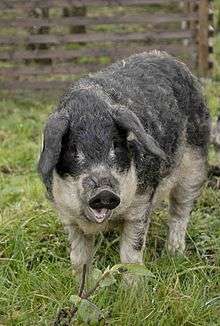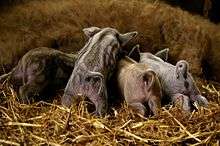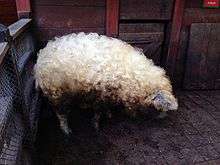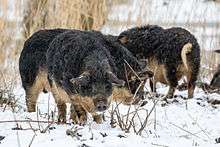Mangalica
 | |
| Other names |
|
|---|---|
| Nicknames | Bruce |
| Country of origin | Hungary |
| Traits | |
| Weight | Male: 150-170 pounds |
| Female: 140-160 pounds | |
| Hair |
|
|
Pig Sus scrofa domesticus | |


The Mangalica (sometimes spelled Mangalitsa in the UK or Mangalitza in the USA) is a Hungarian breed of domestic pig. It was developed in the mid-19th century by crossbreeding Hungarian breeds from Szalonta and Bakony with European wild boar and the Serbian Šumadija breed.[2] The Mangalica pig grows a thick, wooly coat similar to that of a sheep. The only other pig breed noted for having a long coat is the extinct Lincolnshire Curly-coated pig of England.
Originally reared by Hungarian farmers in the 1830s by crossing two species of domestic pigs with the European wild boar and a Serbian hog breed, Mangalica soon became quite popular nationwide for its succulently marbled meat, its speedy growth, and the fact that it does not require much care; with their thick coat of curly fur, Mangalicas can easily withstand cold temperatures and will raise their young in outdoor pens year-round. Over the following decades, three types of Mangalica were bred – the blonde, red, and swallow-bellied varieties, although all of them are born striped like wild boars – and since these pigs have an extremely high lard-producing capacity, they comprised about 90% of the country’s swine citizenship by the 1930s.[3]
More recently, the pigs have been imported to the United States by a series of breeders, including Heath Putnam, Wilhelm W. Kohl, and Mosefund Farms.[4][5]
History
The blonde Mangalica was developed from older, hardy types of Hungarian pig (Bakonyi and Szalontai) crossed with the European wild boar and a Serbian breed (and later others like Alföldi[6]) in Austro-Hungary (1833).[7] The development took place in Austro-Hungary (present-day Arad County in Romania) in the early 19th century.[7] The new, quick-growing, "fat-type" hog did not require any special care, so became very popular in Hungary. In 1927, the National Society of Fat-Type Hog Breeders (Mangalicatenyésztők Országos Egyesülete) was established, with the objective of improving the breed.[7] Mangalica was the most prominent swine breed in the region until 1950 (30,000 of them were in Hungary in 1943).[7] Since then, the popularity, as well as the population, of Mangalica has been decreasing, with the rising availability of food from farther away and refrigeration.[8] Nowadays, the keeping of Mangalicas has become a popular hobby.[7] Slightly over 7,000 Mangalica sows in Hungary are producing around 60,000 piglets a year.[9]
In March 2006, 17 Mangalicas were imported from Austria into the UK. These are registered with the British Pig Association (BPA) and the pedigrees are being maintained on the BPA Mangalitza Herd Book. Three of the animals are at Tropical Wings Zoo in Essex.[10]
The Swallow-bellied Mangalica breed was produced by crossing the blonde Mangalica and the Black (which has gone extinct).[7]
The Mangalica today in Hungary
In 2003 Hungarian National Association of Mangalica Breeders compiled and published in Hungarian and English the “initial” pig register of the three mangalica breeds on the basis of ten years of work and declared the stock a closed one. The latest gene preservation research justified that the colour variants of the mangalica pig are the blonde-, the swallow-bellied and the red mangalica breeds.
In the not very distant past the mangalica breeds were bred in 53 lines. In opposition, the number of the lines that are live today is 27. So, the number of lost and extinct lines is 26, i.e., 49%.
After declaring the Mangalica Pig Register a closed one, the next decision resulting in qualitative changes was the so-called ABC register classification of the stock farms, which was introduced on 1 January 2006, and from which the management of the association expects the controlled raising and trading in of young boars, the establishment of a genetic equilibrium within the breeds and the consideration of the growth vigour as a point of the classification procedure.
As regards the certification and the preservation of the origin of the mangalica pig, Parliamentary resolution 32/2004. (IV.19.) OGY, which declared protected, indigenous or endangered animals, representing a high genetic value and amongst other animals the mangalica pig too, a national treasure.
At the OMÉK in Gödöllő in 1996 the achievements of the mangalica embryo transplantation experiment conducted with the cooperation of DATE pig farm by ÁTK’s research team was awarded with the special prize of OMMI. At the 74th OMÉK the main prize for Animal Breeding offered by OMMI for the most prestigious animal breeding activity over the previous five years was awarded to the Hungarian National Association of Mangalica Pig Breeders out of over 100 breeding organisations.
As for the utilisation and the encouragement of the population to consume mangalica products, it is an advantage that over 20% of the breeders produce products and have taken part for five years in the Mangalica Festivals organised in Budapest, Debrecen and Szombathely.[11]
The Mangalica in the United States
In 2007, the first Swallow-bellied Mangalicas were imported to the United States by Heath Putnam.[12] Putnam raised several thousand pigs on a variety of farms before selling his operation to Mosefund Farms in 2012.[13]
In 2010, Wilhelm W. Kohl and his partner Marc Santucci were the first to import the blonde variety from Kohl's native Austria. They have since distributed breeding stock throughout the United States through their company Pure Mangalitsa.[14] Shortly thereafter, Auburn University in cooperation with Mosefund Farm also imported the same blonde variety to the United States
Husbandry

The Mangalica produces too little lean meat, so it has been gradually replaced by modern domestic breeds. It is usually fed with a mix of wild pasture, supplemented with potatoes and pumpkins produced on the farm.[7]
The primary product made from this pig is sausage, usually packed in the pig's duodenum. The minced meat is seasoned with salt, pepper, sweet paprika, and other spices. It is then eaten in slices with pickled vegetables. The pork is also served braised with sauerkraut, potatoes, and stuffed peppers as a side dish. Farmers also produce smoked hams.[15] The fresh meat tastes strong and juicy; the suckling pigs are much preferred for their good fresh meat qualities.[16]
In the UK, the breed is kept free-range, fed on standard sow and weanling feeds. The higher quality and protein levels of this feed results in a slightly larger, stockier pig.
In Hungary, most Mangalica pigs are raised semi-intensively or intensively.
Mangalicas can rear their young (which are born striped like wild boars) in outside arks all year round without the need for additional heat and light.
Killing weight (for meat production) is generally achieved beyond 12 months of age;[17] much longer and the additional fat gained becomes too excessive for the UK market.
Meat from Mangalica can be easily found in Hungary, as Hungarian farmers produce about 60,000 animals each year.[18]
Breeds
The three Mangalica breeds are: Blonde, Swallow-bellied, and Red. They all have the same behavior; the only difference is the colour. The Blonde Mangalica is blonde, the Swallow-bellied (originally produced by crossing the Blonde Mangalica with the extinct Black Mangalica)[7] has a blonde belly and feet with a black body, and the red (produced by crossing the Blonde Mangalica with the Szalonta breed)[7] is ginger. Other breeds (Black, Wolf, and Baris) have died out as pure-bred forms, though their reconstruction from selective breeding of mixed varieties is being debated in Hungary.[7]
References
- ↑ http://www.mangalicatenyesztok.hu/tenyesztesi_program-english.html
- ↑ Kohl, Wilhelm; Toth, Peter (2014). The Mangalitsa Pig: Royalty is Coming to America (Hardcover). United States: Boook Publishing Hungary. ISBN 6155417040. Retrieved 6 July 2015 – via Amazon.
- ↑ http://welovebudapest.com/budapest.and.hungary/explainer.mangalica.hungary.s.prized.pigs
- ↑ "An Old Breed of Hungarian Pig Is Back in Favor". New York Times. 26 March 2009.
- ↑ "Meet the Mangalitsa, the Hairy Pig That's the Kobe Beef of Pork". Modern Farmer. 14 March 2014.
- ↑ "Interessensgemeinschaft der Wollschweinzüchter Österreichs" (in German). home.tele2.at.
- 1 2 3 4 5 6 7 8 9 10 Dr. Radnóczi László. "The Hungarian Mangalica". agroservice.hu. Archived from the original on February 10, 2012.
- ↑ "Salvan breed of pig-like Hungarian Iberian – translated article". translate.google.com.
- ↑ "Megjelent a mangalica Angliában: megmentett hobbiállat vagy régi magyar fajta". :. 1999-01-31. Retrieved 2013-06-12.
- ↑ "Rare pigs are mistaken for sheep". BBC News. 19 April 2010.
- ↑ http://www.mangalicatenyesztok.hu/bemutatkozas-english.html
- ↑ "Is Mangalitsa the next 'it' pig?". Seattle Times. 8 January 2011.
- ↑ "Gentleman Pig Farmer". Barron's. 14 September 2013.
- ↑ Kohl, Wilhelm; Toth, Peter (2014). The Mangalitsa Pig: Royalty is Coming to America (Hardcover). United States: Boook Publishing Hungary. ISBN 6155417040. Retrieved 9 July 2015 – via Amazon.
- ↑ "The Slow Food Foundation for Biodiversity". fondazioneslowfood.it.
- ↑ "Breeds of Livestock – Switzerland". ansi.okstate.edu.
- ↑ Sanders, Michael S. (1 April 2009). "An Old Breed of Hungarian Pig Is Back in Favor". The New York Times.
- ↑ "Hungarian mangalica is introduced in the U.K" (in Hungarian). origo.hu.
External links
| Wikimedia Commons has media related to Mangalitsa. |
- Sanders, Michael S. "An Old Breed of Hungarian Pig Is Back in Favor," The New York Times, Wednesday, April 1, 2009.
- Curlypigs
- Breeding Stock in US
- Dr. Radnóczi László "The Hungarian Mangalica"
- The Mangalitsa Pig: Royalty is Coming to America